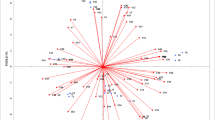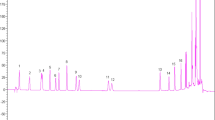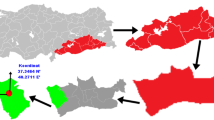Abstract
In this study, the Ayvalik olive variety, an important and widely grown olive variety in Turkey, was chosen. A month prior to blooming and 2 months prior to harvesting in 2011 and 2012, three different concentrations of boron (100, 150 and 250 ppm) were applied to the olive leaves with or without boron deficiencies. After the application, quality criteria, fatty acid composition, total phenol contents and major volatile compounds of olive oil that was obtained from the harvested olives were investigated. Boron application to the olive trees with boron deficiencies has improved both the amount and the olive oil quality. Experimental results show the significance of boron for olive farming. Application of boron in 150 ppm led to a better olive oil quality by improving fatty acid composition [oleic acid (76.03 %), linoleic acid (9.68 %), linolenic acid (0.56 %), monounsaturated fatty acid (77.24 %)], total phenol content (422.94 ppm) and major volatile compounds [E-2-hexenal (43.12 ppm), hexanal (3.02 ppm), Z-3-hexenol (1.13 ppm)] in both harvest seasons (2011–2012) and in both olive orchards with or without boron deficiencies.
Similar content being viewed by others
References
IOOC (2012) Trade standard applying to olive oils and olive-pomace oils. COI/T.15/NC, NO:3, Rev. 7
Frankel E, Bakhouche A, Lozano-Sanchez J, Segura-Carretero A, Fernandez-Gutierrez A (2013) Literature review on production process to obtain extra virgin olive oil enriched in bioactive compounds. potential use of byproducts as alternative sources of polyphenols. J Agric Food Chem 61:5179–5188
Hbaieb RH, Kotti F, Garcia-Rodriguez R, Gargouri M, Sanz C, Perez AG (2015) Monitoring endogenous enzymes during olive fruit ripening and storage: correlation with virgin olive oil phenolic profiles. Food Chem 174:240–247
Anonymous (2007) Türk Gida Kodeksi Yönetmeliği (Turkish Food Codex Regulation). Zeytinyaği ve Pirina Yaği Tebliği No: 2007/36, Resmi Gazete. Ankara
Kiritsakis AK (1998) Flavor components of olive oil—a review. J Am Oil Chem Soc 75:673–681
Salas JJ, Sanchez J (1999) The decrease of virgin olive oil flavor produced by high malaxation temperature is due to inactivation of hydroperoxide lyase. J Agric Food Chem 47:809–812
Flamini G, Cioni PL, Morelli I (2003) Volatiles from leaves, fruits, and virgin oil from Olea europaea Cv. Olivastra seggianese from Italy. J Agric Food Chem 51:1382–1386
Vichi S, Castellote A, Pizzale L, Conte L, Buxaderas S, Tamames E (2003) Analysis of virgin olive oil volatile compounds by headspace solid-phase microextraction coupled to gas chromatography with mass spectrometric and flame ionization detection. Journal of Chromatography A 983:19–33
Kandylis P, Vekiari AS, Kanellaki M, Grati-Kamoun N, Msallem M, Kourkoutas Y (2011) Comparative study of extra virgin olive oil flavor profile of Coronaiki variety (Olea europaea var. Microcarpa alba) cultivated in Greece and Tunisia during one period of harvesting. J Food Sci Technol 44:1333–1341
Longobardi F, Ventrella A, Casiello G, Sacco D, Tasioula-Margari M, Kiritsakis AK, Kontominas MG (2012) Characterisation of the geographical origin of Western Greek virgin olive oils based on instrumental and multivariate statistical analysis. Food Chem 133:169–175
Franco MN, Galeano-Diaz T, Lopez O, Fernandez-Bolanos JG, Sanchez J, De Miguel C, Gil MV, Martin-Vertedor D (2014) Phenolic compounds and antioxidant capacity of virgin olive oil. Food Chem 163:289–298
Kalua CM, Allen MS, Bedgood DR, Bishop AC, Prenzler PD, Robards K (2007) Olive oil volatile compounds, flavour, development and quality: a critical review. Food Chem 100:273–286
Angerosa F (2002) Influence of volatile compounds on virgin olive oil quality evaluated by analytical approaches and sensor panels. Eur J Lipid Sci Technol 104:639–660
Sanchez J, Harwood JL (2002) Biosynthesis of triacylglycerols and volatiles in olives. Eur J Lipid Sci Technol 104:564–573
Tura D, Prenzler P, Bedgood D, Antolovich M, Robards K (2004) Varietal and processing effects on the volatile profile of Australian olive oils. Food Chem 84:341–349
Marschner H (1995). Mineral nutrition of higher plants, 2nd. edn. Academic Press, New York
Yazied AEA, Mady MA (2012) Effect of boron and yeast extract foliar application on growth, pod setting and both. Journal of Applied Sciences Research 8(2):1240–1251
Goldbach HE, Grill JB, Lendeman N, Porzelt M, Horrmann C, Lupp B, Gess-mer B (1991) Influence of boron on net proton release and its relation to other metabolic processes. Curr. Topics Plant Biochem. Physiol. 10:195–220
Kamal BA (2000) Physiological studies on nutrition status and productivity of olive trees under new lands condition, Ph.D. thesis, Zagazig University, Egypt
Desouky IM, Laila F, Haggag MM, El-Migeed M, Kishk YFM, El-Hady ES (2009) Effect of boron and calcium nutrients sprays on fruit set, oil content and oil quality of some olive oil cultivars. J Agric Sci 5:180–185
Ramezani S, Shekafandeh A, Taslimpour MR (2010) Effect of GA3 and zinc sulfate on fruit yield and oil percentage of Shengeh olive trees. Int. J. Fruit Sci. 10:228–234
IOOC (2011) Guide for the Determination of the Characteristics of Oil-Olives. International Olive Oil Council COI/OH/Doc. No 1
EC (1991) Commission regulation EEC 2568/91 on the characteristics of olive oil and olive pomace and their analytical methods. Off. J. Eur. Commun. L248
Gutfinger T (1981) Polyphenols in olive oils. J Am Oil Chem Soc 58:966–968
Boskou D (1996) Olive Oil Chemistry and Technology. AOCS Press, pp. 52–83
Allalout A, Krichene D, Methenni K, Taamalli A, Oueslati I, Daoud D (2009) Characterization of virgin olive oil from super intensive Spanish and Greek varieties grown in Northern Tunisia. Sci Hortic 120:77–83
Youssef O, Guido F, Manel I, Yuossef N, Luigi C, Mohamed H, Daoud D, Mokhtar Z (2011) Volatile compounds and compositional quality of virgin olive oil from Questati variety: influence of geographical origin. Food Chem 124:1770–1776
Karabagias I, Michos CH, Badeka A, Kontakos S, Stratis I, Kontominas MG (2013) Classification of Western Greek virgin olive oils according to geographical origin based on chromatographic, spectroscopic, conventional and chemometric analyses. Food Res Int 54:1950–1958
Reboredo-Rodríguez P, González-Barreiro C, Cancho-Grande B, Fregapane G, Salvador MD, Simal-Gandara J (2015) Characterisation of extra virgin olive oils from Galician autochthonous varieties and their co-crushings with Arbequina and Picual cv. Food Chem 176:493–503
Gutierrez-Rosales F, Arnaud T (2001) Contribution of Polyphenols on the Oxidative Stability of Virgin Olive Oil. 24th World Congress ISF Berlin, Proceedings, 61-62
Baccouri O, Bendini A, Cerretani L, Guerfel M, Baccouri B, Lercker G, Zarrouk M, Daoud Ben Miled D (2008) Comparative study on volatile compounds from Tunisian and Sicilian monovarietal virgin olive oils. Food Chem 111:322–328
Mousa YM, Gerasopoulos D (1996) Effect of altitude on fruit and oil quality characteristics of ‘Mastoides’ olives. J Sci Food Agric 71:345–350
Caponio F, Gomes T (2001) Pasqualone, A. Phenolic compounds in virgin olive oils: influence of the degree of olive ripeness on organoleptic characteristics and shelf-life. Eur Food Res Technol 212:329–333
Hbaieb RH, Kotti F, García-Rodríguez R, Gargouri M, Sanz C, Pérez AG (2015) Monitoring endogenous enzymes during olive fruit ripening and storage: correlation with virgin olive oil phenolic profiles. Food Chem 174:240–247
Sousa A, Malheiro R, Casal S, Bento A, Pereira JA (2014) Antioxidant activity and phenolic composition of Cv. Cobrançosa olives affected through the maturation process. J Func Foods 11:20–29
Beltran G, Aguilera M, Rio C, Sanchez S, Martinez L (2005) Influence of fruit ripening process on the natural antioxidant content of Hojiblanca virgin olive oils. Food Chem 89:207–215
Rodney JM, Ayton J, Graham K (2010) The influence of growing region, cultivar and harvest timing on the diversity of Australian olive oil. J Am Oil Chem Soc 87:877–884
Saadati S, Moallemi N, Mortazavi SMH, Seyyednejad SM (2013) Effects of zinc and boron foliar application on soluble carbohydrate and oil contents of three olive cultivars during fruit ripening. Sci Hortic 164:30–34
Angerosa F, Mostallino R, Basti C, Vito R (2000) Virgin olive oil odour notes: their relationships with volatile compounds from the lipoxygenase pathway and secoiridoid compounds. Food Chem 68:283–287
Cavalli J, Fernandez X, Cuvelier L, Loiseau A (2004) Characterisation of volatile compounds of French and Spanish virgin olive oils by HS-SPME: identification of quality freshness markers. Food Chem 88:151–157
Contini M, Esti M (2006) Effect of the matrix volatile composition in the headspace solid-phase microextraction analysis of extra virgin olive oil. Food Chem 94:143–150
Mania H, Mahjoub F, Oueslati I, Daoud D, Zarrouk M (2008) Characterization of monovarietal virgin olive oils from six crossing varieties. Sci Hortic 115:252–260
Toker C (2009) Research on determination of fruit quality and aroma compounds of Ayvalik olive variety grown under northern Aegean agro-ecological conditions, Ph.D. thesis, Ege University, Turkey
Ortiz AS, Segura CR, Sanz C, Perez AG (2012) Synthesis of volatile compounds of virgin olive oil is limited by the lipoxygenase activity load during the oil extraction process. J Agric Food Chem 60:812–822
Reboredo-Rodriguez P, Gonzalez-Barreiro C, Cancho-Grande B, Simal-Gandara J (2013) Aroma biogenesis and distribution between olive pulps and seeds with identification of aroma trends among cultivars. Food Chem 141:637–643
Bubola KB, Koprivnjak O, Sladonja B, Belobrajic I (2014) Influence of storage temperature on quality parameters, phenols and volatile compounds of Croatian virgin olive oils. Grasas Aceites 65(3):e034. doi:10.3989/gya.0222141
Olias JM, Perez AG, Rios J, Sanz LC (1993) Aroma of virgin olive oil. J Agric Food Chem 41:2368–2373
Anthon GE, Barrett DM (2003) Thermal inactivation of lipoxygenase and hydroperoxytrienoic acid lyase in tomatoes. Food Chem 81:275–279
Runcio A, Sorgona L, Mincione A, Santacaterina S, Poiana M (2008) Volatile compounds of virgin olive oil obtained from Italian cultivars grown in Calabria. Effect of processing methods, cultivar, stone removal, and anthracnose attack. Food Chem 106:735–740
Peres F, Jeleń HH, Majcher MM, Arraias M, Martins LL, Ferreira-Dias S (2013) Characterization of aroma compounds in Portuguese extra virgin olive oils from Galega vulgar and Cobrançosa cultivars using GC–O and GC × GC–ToFMS. Food Res Int 54:1979–1986
Luna G, Morales MT, Aparicio R (2006) Characterisation of 39 varietal virgin olive oils by their volatile compositions. Food Chem 98:243–252
Salvador MD, Aranda F, Fregapane G (2001) Influence of fruit ripening on Cornicabra virgin olive oil quality: a study of four successive crop seasons. Food Chem 73:45–53
Author information
Authors and Affiliations
Corresponding author
About this article
Cite this article
Toker, C., Yavuz, N. The Effect of Boron Application on Chemical Characterization and Volatile Compounds of Virgin Olive Oil of Ayvalik Olive Cultivar. J Am Oil Chem Soc 92, 1421–1428 (2015). https://doi.org/10.1007/s11746-015-2703-7
Received:
Revised:
Accepted:
Published:
Issue Date:
DOI: https://doi.org/10.1007/s11746-015-2703-7




